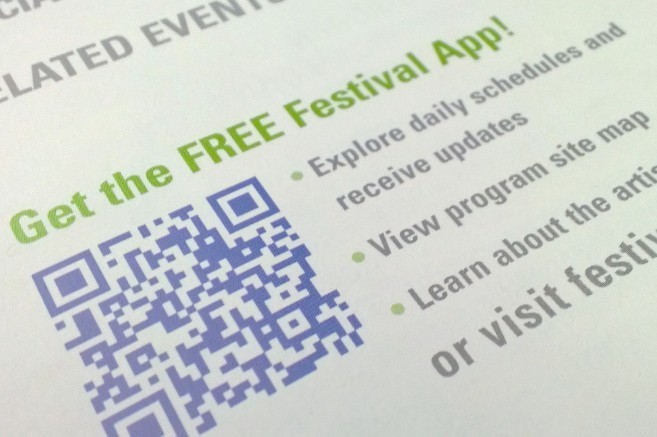QR Codes in Cultural Education: Are They Worth It?

Have you noticed the black and white patterned squares on signs and advertisements, offering more information? These are quick response (QR) codes! First created for use in the auto industry in the mid-1990s as a more effective alternative to traditional barcodes, QR codes have been used in different ways over the years.
At the Smithsonian Center for Folklife and Cultural Heritage, we are evaluating whether or not to use them at the 2014 Folklife Festival. In 2013, the codes were used primarily in Festival brochures for fundraising and on Festival signs for access to the Festival App. We were unable to include a tracking function in the codes, so we could not quantify usage.
I decided to investigate QR codes further to understand why people use or don’t use QR codes and how they impact the Festival experience. To gather information on the effectiveness of QR codes within the field of cultural education, education specialist Betty Belanus sent out inquiries via e-mail lists within the Smithsonian and to public sector folklorists across the country; our questions were also posted on the social media sites of some of our colleagues. We received approximately forty-seven responses: thirty-two by email and fifteen from social media sites.
I found it is important to analyze QR code implementation and use as a process. First, cultural educators must decide if they want to create and display codes. Some educators reported that the codes require very little initial investment of time and money. Others felt they distract energy and focus away from more important and rewarding elements of their exhibit. For every institution, this first step will be different depending on the type of exhibit and the existing technology.
When educators choose to create and display QR codes, the process advances to the second step: visitor use. If QR codes are available, will visitors use them? At the Smithsonian, the average visitor who uses QR codes is university-educated, male, in his mid-thirties to fifties, with an average annual income of more than $50,000. Other institutions reported that QR codes are used primarily by younger demographics. Many educators reported that people enjoy using QR codes, claiming they enhance the educational experience by making it more interactive.
Alternatively, some educators are concerned that QR codes exclude visitors who don’t own smart phones or other devices that read QR codes. Educators should think consciously about how technology impacts different demographics and decide how they can best use technology to improve access to information for all audiences.
The final step is to evaluate the effectiveness of the QR code as a technology. Some educators are enthusiastic about their widespread use in Asia and potential for use in the United States. They believe the codes are a cutting-edge technology that improve visitor experience and engagement, especially among younger audiences. Others claim QR codes are already obsolete, or certainly less relevant than apps (short for applications).
Based on my research into QR codes, here are some recommendations for educators. Our survey feedback finds that if educators choose to use QR codes, they should try their best to do three things:
- Raise visitor awareness of the codes with explanations, reminders, and visually interesting displays;
- Make the codes interactive, utilizing games and familiar social media platforms;
- Provide Wi-Fi and small, portable computers for users without smart phones.
If educators choose to forego the use of QR codes, our survey results suggest providing a short URL or use an app to allow visitors to access additional content instead.
Ultimately, this study emphasizes the concept that all technologies, including QR codes, are tools. Cultural educators must navigate the literature to identify the advantages and disadvantages of each, and decide which technologies are good fits for their institutions on a case-by-case basis.
We would like to thank the educators who took the time to send us their information and opinions. I hope you, too, learned something valuable about the best practices of using QR codes in cultural education.
More resources for QR code use in museums:
- “QR Codes and Visitor Motivation: Tell Them What They’ll Get with that Shiny Gadget” on Museum 2.0
- “QR Codes in Museums” on The Mobilists
- Download Katie Fernandez’s PowerPoint presentation on QR codes seen below
Katie Fernandez is an undergraduate at the University of California, Santa Cruz. She is majoring in anthropology with a minor in education. This fall, as an intern at the Center for Folklife and Cultural Heritage, she worked on educational materials and evaluating the 2013 Folklife Festival.

